Our Lady of the Abandoned Parish Church (Marikina)
The Diocesan Shrine and Parish of Our Lady of the Abandoned (Spanish: Santuario y Parroquia de Nuestra Señora de los Desamparados; Tagalog: Dambanang Pandiyosesis at Parokya ng Ina ng mga Walang Mag-Ampon), better known as Our Lady of the Abandoned Parish Church, is a Roman Catholic church in Marikina, the Philippines. The church enshrines one of several images of the Madonna and Child venerated as miraculous, which has received papal recognition.
| Diocesan Shrine and Parish of Our Lady of the Abandoned (Dambanang Pandiyosesis at Parokya ng Ina ng mga Walang Mag-Ampon) | |
|---|---|
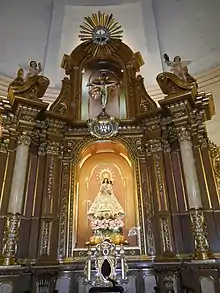 | |
| Religion | |
| Affiliation | Roman Catholic |
| Ecclesiastical or organizational status | Diocesan (Antipolo) |
| Leadership | Most Rev. Nolly C. Buco J.C.D., D.D., Rector and Parish Priest |
| Year consecrated | 1690 |
| Location | |
| Location | J.P. Rizal cor. V. Gomez Sts., Santa Elena, Marikina, Philippines |
| Architecture | |
| Type | Baroque Church |
| Style | Baroque |
| Completed | 1572 |
| Materials | Adobe, sand, gravel, cement, mortar, and steel |

The church itself is a testament of a religious controversy rooting back from Marikina's early history wherein both the Jesuits and Augustinians fought over the ecclesiastical control of the area.[1] The church is also known for featuring Metro Manila's Longest Holy Week Processions with around 80 floats as of 2018, and the third overall after the St Augustine Parish in the Town of Baliuag and the San Isidro Labrador Parish in the Town of Pulilan, both located in the province of Bulacan and featuring at least 110 floats.
History
Early years
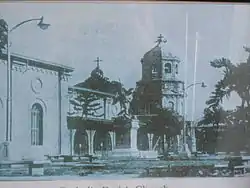
Catholicism in what is now Marikina began when the settlement was again ceded to the Augustinians by the Jesuits. On March 10, 1687, Governor Gabriel Cruz Elasque ordered the transfer of Marikina to the oversight of the Augustinians and merged with the ministry of San Mateo. He instructed Don Juan Pimentel, the Mayor of Tondo, to vacate and demolish the visita of Jesús de la Peña as the Marikina River would flood the site during the rainy season. The visita could not accommodate the growing congregation, forcing the Austin friars to transfer operations across the Marikina to higher ground, where the much larger, present structure was built. The church was subsequently made an independent parish in 1690.
The Venerated Image
On October 23, 1791 the church was consecrated by the Archdiocese of Manila for the Virgin's said title so that it could not be used for any secular purpose. In 1898, during the Philippine–American War, the first image was burnt along with pertinent records of the devotion in Marikina. In 1902, a new image was created, and is the one presently venerated in the parish.
Restoration
The church suffered major damages during the tumultuous years of the Philippine–American War in the early 1900s and the carillion was totally destroyed during the second world war. By 1957, OLA church was restored and refurbished by Father Silvestre dela Cruz of Archdiocese of Manila with the help from various religious and civic organisations.[2]
The Episcopal Coronation
The community initially approached the Apostolic Nuncio to petition for the Canonical Coronation of the image; however, the petition was declined due to few supporting documents. Meanwhile, then Bishop of Antipolo Crisostomo Yalung honored the Patrona with an Episcopal Coronation to remember the 100th Anniversary of the venerated image. The celebration was held on May 12, 2002 wherein the coronation was facilitated by Former President Gloria Macapagal-Arroyo.
The Canonical Coronation
By virtue of a decree granted by the Holy See through Pope Benedict XVI, the venerated image of Our Lady of the Abandoned was canonically crowned on 23 October 2005. Manila Archbishop Gaudencio Cardinal Rosales headed the Holy Mass and Canonical Rites together with the Antipolo Bishop Gabriel V. Reyes and Parish Priest Rev. Msgr. Arnel F. Lagarejos.
The Architecture
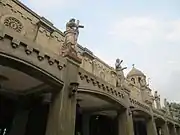
The church was first constructed from bamboo and leaves by the Augustinian friars in a place called Chorillo (present-day Barangka) on 1572. On 1687, the real construction began in its present location to stabilize an ecclesiastical jurisdiction over the area. Constructed in Baroque style, it is characterized by a heavily fortified facade, large-scale ceiling paintings, a dramatic central projection of the facade, a round-style pediment for the bell-tower and the opulent blending of painting and architecture.
Parish Priests
The following were the priests assigned to the parish based on extant records:
| Name | Years serving | Present assignment |
|---|---|---|
| P. Jose Rodriguez | 1768 – 1806 | Deceased |
| P. Jose Ma. Herrera | 1806 – 1852 | Deceased |
| P. Vicente Reig | 1852 – 1864 | Deceased |
| P. Jacinto Zamora | 1864 (Interim) | Deceased |
| P. Jose Ma. Zamora | 1865 – 1899 | Deceased |
| P. Patricio Calderon | 1900 – 1901 | Deceased |
| P. Lorenzo Gregorio | 1904 | Deceased |
| P. Vicente Estacio | 1904 | Deceased |
| P. Ricardo Pulido | 1905 – 1917 | Deceased |
| P. Jorge Capistrano | 1917 – 1932 | Deceased |
| P. Luis Mojica | 1932 – 1941 | Deceased |
| P. Pedro Hizon | 1941 | Deceased |
| P. Pedro Hilario | 1941 | Deceased |
| Fr. Conrado C. Arciaga | 1941 – 1951 | Deceased |
| Fr. Gabino S. Baluyot | 1951 | Deceased |
| Msgr. Hernando Godoy, HP | 1954 – 1956 | Deceased |
| Fr. Silvestre dela Cruz | 1956 – 1959 | Deceased |
| Msgr. Florentino C. Fuentes, HP | 1959 – 1963 | Deceased |
| Fr. Gerardo Maximo | 1963 – 1965 | Deceased |
| Msgr. Jose B. Cruz, PA, PA | 1965 – 1986 | Deceased |
| Msgr. Generoso A. Mediarito, PC, PC | 1986 – 1992 | Diocesan Shrine and Parish of Saint Therese of the Child Jesus, Masinag, Antipolo City |
| Msgr. Teodoro D. Perez, PA | 1992 – 2000 | Deceased |
| Msgr. Arnel F. Lagarejos, PC, STD | 2000 – 2006 | Last Assignment: Parish Priest of Saint John the Baptist Parish, Taytay, Rizal (2017) |
| Msgr. Mariano T. Balbago Jr., PC | 2006 – 2007 | St. Joseph Catholic Church, Beltsville, Maryland, USA (Archdiocese of Washington) |
| Francisco M. de Leon, D.D., MS | 2006 – 2016 | Bishop of Antipolo |
| Fr. Reynante U. Tolentino | 2016 – 2017 | Immaculate Conception Parish, National Shrine of Our Lady of Peace and Good Voyage, Cathedral of Antipolo |
| Msgr. Pedro C. Cañonero | 2017 – 2019 | Cainta Catholic College - School Director |
| Most Rev. Nolly C. Buco, J.C.D., D.D. | from 2019 | Auxiliary Bishop of Antipolo, Parish Priest of the
Diocesan Shrine and Parish of Our Lady of the Abandoned |
Shrine Rectors
On August 5, 2007, which is the Feast of the Dedication of the Basilica of St. Mary Major in Rome, the Bishop of Antipolo, Gabriel V. Reyes, D.D., consecrated the Parish Church of Our Lady of the Abandoned as a diocesan shrine in honor of Our Lady under the title Maria, Inang Mapag-Ampon ng Marikina, Nuestra Señora de los Desamparados. On September 8, 2007, a little more than a month after the dedication of the church as a shrine, Bishop Francisco de Leon, who had been appointed by Pope Benedict XVI as Auxiliary Bishop of Antipolo, was assigned by the Bishop of Antipolo as Parish Priest of Our Lady of the Abandoned. Msgr. Mariano Balbago Jr. relinquished the title of parish priest, but was appointed Rector and Parish Administrator, assisting Bishop De Leon in his duties. Upon the departure of Msgr. Balbago from the shrine and parish, Bishop De Leon was also appointed rector by the Bishop of Antipolo, but this time assisted by vice rector and parish administrator Fr. Reynante U. Tolentino.
| Name | Years serving | Assignment |
|---|---|---|
| Rev. Msgr. Mariano T. Balbago Jr. | 2007 – 2009 | Rector and Parish Administrator |
| Bishop Francisco M. de Leon, D.D., MS | 2009 – 2016 | Rector and Parish Priest |
| Rev. Fr. Reynante U. Tolentino | 2009 – 2016 | Vice-Rector and Parish Administrator |
| Rev. Fr. Reynante U. Tolentino | 2016 – 2017 | Acting Rector and Parish Priest |
| Rev. Msgr. Pedro C. Cañonero | 2017 – 2019 | Rector and Parish Priest |
| Rev. Fr. Francisco Louie M. Deang | 2019 – present | Rector and Parish Administrator |
Assisting in the Pastoral Team of the parish are as follows:
- Fr. Edward Bacus - Guest Parochial Vicar
- Fr. Conegundo Garganta - Attached Priest
- Rev. Fr. Francisco Louie M. Deang - Rector and Parish Administrator
Gallery
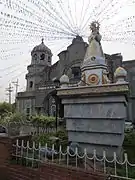 Nuestra Señora de los Desamparados in front of the OLA Church.
Nuestra Señora de los Desamparados in front of the OLA Church. A closer view of the altar with the massive overhead arches.
A closer view of the altar with the massive overhead arches.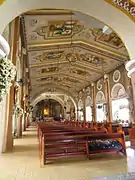 Arches are a common feature of the church.
Arches are a common feature of the church. An inside look of the OLA Church.
An inside look of the OLA Church. Another view from the aisle.
Another view from the aisle. The Our Lady of Abandoned's ceiling is painted with various images of Jesus' ministry according to the Bible.
The Our Lady of Abandoned's ceiling is painted with various images of Jesus' ministry according to the Bible. A ceiling painting of the main dome depicting the descent of the Holy Spirit as tongues of fire which settled over the head of each of Jesus' disciples.
A ceiling painting of the main dome depicting the descent of the Holy Spirit as tongues of fire which settled over the head of each of Jesus' disciples.
References
- Buenconsejo, Maria Lourdes (April 2013). Marikina 1630. Marikina City Library.
- Buenconsejo, Maria Lourdes (April 2013). Marikina 1630. Marikina City Library.
External links
| Wikimedia Commons has media related to Our Lady of the Abandoned Parish Church (Marikina, Metro Manila). |